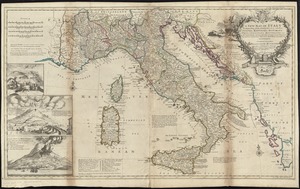A new map of Italy distinguishing all the sovereignties in it, whether states, kingdoms, dutchies, principalities, republicks, &c : with the post roads, and many remarks not extant in any map
Item Information
- Title:
- A new map of Italy distinguishing all the sovereignties in it, whether states, kingdoms, dutchies, principalities, republicks, &c : with the post roads, and many remarks not extant in any map
- Description:
-
This map could easily have been titled "A Disaster-lovers Guide to Italy," filled as it is with pictures and vivid descriptions of infestations, eruptions, and earthquakes. Mt. Aetna is described as a mountain that "sometimes issues out pure flame, and at other times a thick smoke with ashes & streams of fire run down, with great quantities of burning stones, and [it] has made many great eruptions." Eruptions of Mts. Aeolius, Vesuvius, and Aetna are vividly depicted in the insets at the left. The town of Syracuse ("Siracusa") on the island of Sicily is said to have been "almost entirely ruin'd" by the earthquake of January 11, 1693. In fact, the city was completely destroyed and thousands lost their lives. Further north, Taranto is said to be the home of the tarantula, since the giant spiders "abound in the neighborhood, their sting is very dangerous, makes people weep, dance, tremble, vomit, laugh, faint and die if they are not relieved by musick which sets them dancing and dissipates the poison by the exercise." There was in fact a neurological disorder once prevalent in this part of Italy called "tarantism," which induced in the sufferer a kind of hysteria, including a sudden inclination to dance and spin -- the perspiration of dancing helped the body to heal itself. It was commonly thought, as expressed on this map, that the illness itself was brought on by the bite of the tarantula and that the dance was the cure. The Italian folkdance, the tarantella, originates from this folktale.
- Creator:
- Moll, Herman, d. 1732
- Contributor:
- Bowles, John, 1701-1779
- Contributor:
- Bowles, Thomas, d. 1767
- Contributor:
- Overton, Philip, d. 1751
- Contributor:
- King, John
- Name on Item:
-
according to ye newest and most exact observations by H. Moll
- Date:
-
1714
- Format:
-
Maps/Atlases
- Location:
-
Boston Public Library
Norman B. Leventhal Map & Education Center - Collection (local):
-
Norman B. Leventhal Map & Education Center Collection
- Subjects:
-
Volcanoes--Italy--Pictorial works--Early works to 1800
Italy--Maps--Early works to 1800
Eugene, of Savoy, Prince of Savoy, 1663-1736
- Places:
-
Italy
- Extent:
- 1 map : hand col. ; 60 x 99 cm.
- Terms of Use:
-
No known copyright restrictions.
No known restrictions on use.
- Publisher:
-
London :
Printed for H. Moll ... Jno. Bowles ... and T. Bowles ... and by Philip Overton ... and by John King
- Scale:
-
Scale [1:1,850,000]
- Language:
-
English
Latin
- Notes:
-
Relief shown pictorially.
Prime meridians: London and Ferro.
Inset views: A cataract of air in Mount Aeolius in Italy -- Mont Vesuvius two leagues from Naples -- Mount Aetna or Mongibello in Sicily beeing a true draught of ye eruption in 1669.
Includes dedication to Francisco Eugenio Sabaudiae and notes.
Copy 2 appears in Moll's The world described, [1709-1736], plate 27.
Map in English. Dedication in Latin.
Exhibited in “Faces and Places,” at the Boston Public Library, Boston, MA, October 2003 - September 2004.
- Identifier:
-
05_04_000040
- Call #:
-
G6710 1714 .M65
- Barcode:
-
39999052507702





